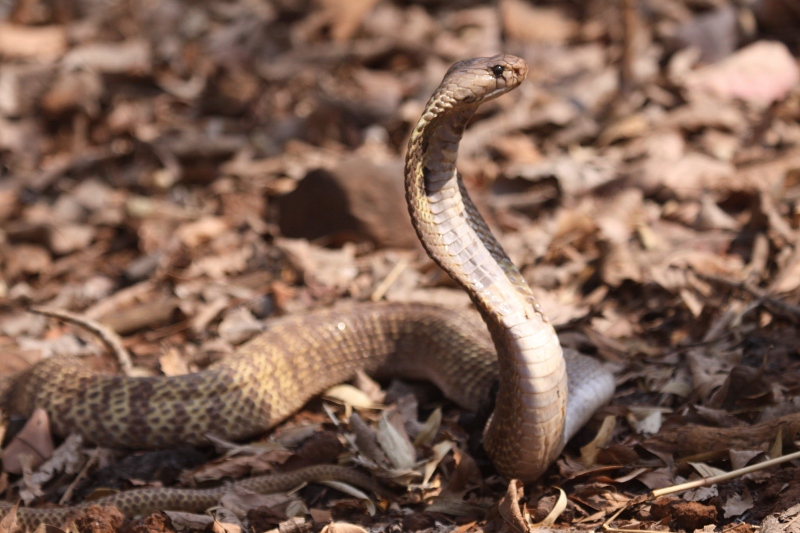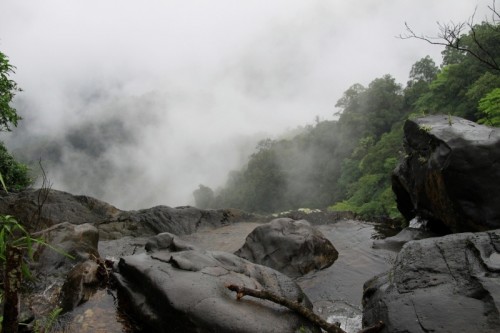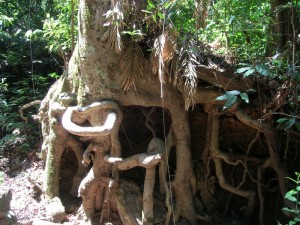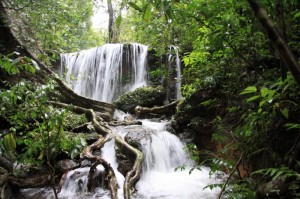TBI Wildlife: In Search Of The King At Agumbe
A beautiful rainforest set in the Western Ghats, Agumbe is home to some of the most beautiful species on the planet. Besides many exotic varieties of plants, animals, insects, butterflies, reptiles and birds, one can also find oneself, on a lucky day, face to face with the King Cobra!

Gangadharan Menon takes us on a mesmerizing trip to Agumbe – one of the densest rainforests in India. While hoping to see the King Cobra in all its glory, he gets a chance to soak in the splendour of the rich flora and fauna, while getting soaked to the bone in incessant rain. In this dream-like account of his adventure, with a generous sprinkling of breath-taking facts, he takes us into the heart of the Western Ghats, which was recently declared a World Heritage Site.
It rained and it rained, for five days and five nights. Whenever there was a momentary respite, unseen birds would sing from trees that had long back disappeared into the mist.
It was the second coming of the monsoon. Just when everyone thought it was the end of the season, it met us on the border of Goa and Karnataka, and travelled with us all the way to Udipi, and then up into the magical mountains of Agumbe.

Agumbe in the Western Ghats receives the second highest rainfall in India. And when it rains here, there are very few places on earth that are as enchanting. Agumbe has 54 square kilometers of pristine rainforests teeming with wildlife that is endemic to this unique habitat. Apart from being home to an exotic variety of insects, flowers, birds and butterflies, it’s also the land of reptiles, and the capital of the most mysterious snake of them all, the King Cobra.

Walking past the snake shrine and the temple pond near Agumbe Rainforest Research Station, I was reminded of a similar shrine in my ancestral home in Kerala. My fascination for snakes started from that shrine, somewhere in my childhood. My great grandmother used to feed milk to the snakes that inhabited the shrine, once a year. Family folklore has it that once she forgot all about the ritual, and a golden snake crawled into our house to gently remind her of the lapse! My early memories of that snake shrine are one of fear and fascination. Made of black stone, it instantly invoked a primordial respect. And it stood majestically under a canopy of ancient, intertwined creepers that looked like snakes in perpetual copulation. Every day a stone lamp would be lit there, and I would accompany my grandmother in the hope of getting a glimpse of the golden snake.
When we reached the Research Station at Agumbe, we were asked to unpack our bags at the guest house and immediately start on our trek to the Onakke Abbe Waterfalls.
We walked through curtains after curtains of rainfall, and despite the heavy rain gear that we had worn, we were drenched to the bone in a matter of minutes. The rain falling incessantly on the evergreen leaves created a pitter patter that had the monotone of meditative music. Even the sun trying to pierce the translucent clouds created a silvery light that enveloped the entire forest. Suddenly the forest path narrowed, and in front of us there was a carpet of decayed leaves teeming with leeches. As we continued our march into the heart of the rainforest, it dawned on me that leeches are the forests’ first line of defence, keeping unwanted guests at bay. After an arduous pilgrimage, we reached Onakke and saw the breathtaking sight of a waterfall taking a sheer drop of over 300 feet into a valley of mist. And the best part of the view was that we were right on top of this magnificent waterfall, looking down at the white cascade.

On our way back, we took a short cut. And we realized to our dismay that a short cut in a forest doesn’t mean reaching faster. On the path less travelled there were many gigantic trees that had fallen down creating an Olympian hurdle. We had to climb over these massive trunks every 100 metres to reach the base camp.
Our next trip was in the night. Armed with searchlights, we ventured to see the night life of the forest. Right near the gate was a lime tree on which all the four stages of a butterfly were seen on four different branches: the egg, the larva, the pupa and the butterfly! The common mormon butterfly that emerged during the day was lingering on the mother tree, just for one more night, before taking off into its own dawn.
Then on the tree tops, snuggling into each other, was a shy, elusive pair of Slender Loris, with their large eyes gleaming eerily in the light of the torch.

Next up was the exotic Malabar Gliding Frog, camouflaged so perfectly that only the eagle eyes of Vipul, our friend, philosopher and guide, could have spotted it. As part of our orientation, he picked it up gently from the leaf. As if to justify its name, it glided from Vipul’s hand to mine. And then Vipul explained to me an amazing fact about this frog. Though green in colour, it has two thick red lines running along its sides. When it sits on a leaf it flattens its body completely so that this ‘manufacturing defect’ is hidden, and it’s completely camouflaged with the evergreen leaf!
On our way back, we stopped by at the place where Saroja had spotted a Pit Viper in the afternoon. The attempt was futile; but I couldn’t help thinking that just as we were looking for it, it must have been watching us from the dense foliage nearby.

Back at the camp, we were lulled into sleep by the soothing raga of the brooks that flowed on either side of the cottage, and the pleasant rhythm of the raindrops falling on the tiled roof. It must have been the Megh Malhar raga.
The next morning, we sighted a slender, green vine snake just outside the cottage. As we approached it, it opened its large, red mouth as a matter of defensive display. Assuring that it’s completely non-poisonous, Vipul gently lifted it off the tree and transferred it into my hands, and it slithered up to my shoulder. And I remembered that distant afternoon when I accidentally met Romulus Whitaker, the Snake-man of India, and the head of Agumbe Rainforest Research Station. It was 34 years ago. I had gone with my English Professor Shama Futehally to her sister Zai’s house in Bandra. As I sat on a sofa waiting for Shama to finish her work, I saw a couple of snakes sliding into the drawing room from the bedroom. Soon, there were half a dozen of them. One of them dared to climb the sofa and slither towards my mortified hand. Just as it started climbing up to my shoulder, another one slithered across my frozen feet. It was a moment of truth for me, as it marked the end of my fear of snakes and the beginning of my love for them. Later, Shama told me that these were injured, non-poisonous snakes rescued by Rom, and were to be treated and then released in the forests of Sanjay Gandhi National Park.

Back at Agumbe, there was no respite from the downpour. After a few moments of the joy of wearing dry clothes, we were back in the midst of torrential rain as we proceeded to a picturesque hill called Kundadri. After a steady climb along a road that was surprisingly lined with yellow flowers on one side, and white flowers on the other, we reached the top. And there, the serpentine road stopped abruptly at the stone sculpture of a snake. Beyond that sculpture was a dilapidated Jain temple. And all around the temple were mountains floating in the mist. To the right of the temple was an amazing pond, where the water level remains exactly the same, in the height of monsoon and the peak of summer!

The evening trek was to discover Vipul’s secret waterfall. Walking adventurously through a rivulet in spate, wrapped in endless sheets of rainfall, we reached a massive tree, its buttress roots measuring a whopping 40 feet across. Endemic to tropical rainforests, these trees spread their roots far and wide above the ground, to trap the leaves that fall incessantly. In the crevices of these roots the leaves decay, and become the nutrition for the tree to grow further and further into the skies. As we turned the next corner we saw the pleasing sight of a friendly waterfall; the kind that’s gentle and beautiful, rather than the kind that inspires awe. It’s where Vipul retreats in his private moments for meditating on life and its meaning.
Then came the highpoint of our trip. Here at Agumbe, the very first study of King Cobra in his natural habitat was underway. Its behaviour was being observed by implanting a transmitter in its body and then tracking its movements with a receiver. The King currently being tracked was in a self-imposed exile in a termite mound at the outskirts of a village called Kesargonda. It had disappeared into the mound and hadn’t come out for two weeks now.

A lot is known about the King, but more is unknown. It’s known that King Cobra is the only snake-eating snake. It’s the largest venomous snake in the world, measuring up to 15 feet at its best. It’s the only snake that builds a nest to lay its eggs. It doesn’t normally waste its venom on humans, since the venom is precious and in short supply. And when the hatchlings came out of the eggs, the Queen slowly slithers away, lest its instinct to eat other snakes overpowers its maternal instinct!
In the evening, Gowrishankar, the head of ARRS, and his wife Sharmila, took us to Dodda Maney in the town of Agumbe, to see a 150-year old heritage house, peopled with some of the most beautiful smiles you can ever hope to see. It’s the house where Malgudi Days was filmed.
When we were returning in the night, Gowri was at the wheel. Suddenly he pressed the brake, and the vehicle came to a screeching halt in the stillness of the forest. He got down and gently picked up a little, bronze-coloured snake that was about to cross the road. And walking in the torrential rain, he deposited it safely on an overhanging branch, and came back with a smile that had traces of relief in it.

On the last morning, right in front of the cottage in the yonder paddy fields, there were three large egrets and a pair of white-necked storks swimming silently in the mist. And as we bid farewell to Vipul and his gang at the gate, we knew that we were leaving a part of us behind at Agumbe, only to come back on another rain-soaked day to reclaim it.
Passing by Gowri’s house, I remembered the warmth with which he had carried the little snake back to where it belonged: the dark, mysterious rainforests of Agumbe. And I knew in my heart that one day the elusive Kings of Agumbe would reveal all their dark, mysterious secrets to him. Sooner, than later.
All Photos by Gangadharan Menon
If you found our stories insightful, informative, or even just enjoyable, we invite you to consider making a voluntary payment to support the work we do at The Better India. Your contribution helps us continue producing quality content that educates, inspires, and drives positive change.
Choose one of the payment options below for your contribution-
By paying for the stories you value, you directly contribute to sustaining our efforts focused on making a difference in the world. Together, let’s ensure that impactful stories continue to be told and shared, enriching lives and communities alike.
Thank you for your support. Here are some frequently asked questions you might find helpful to know why you are contributing?


This story made me
-
97
-
121
-
89
-
167











